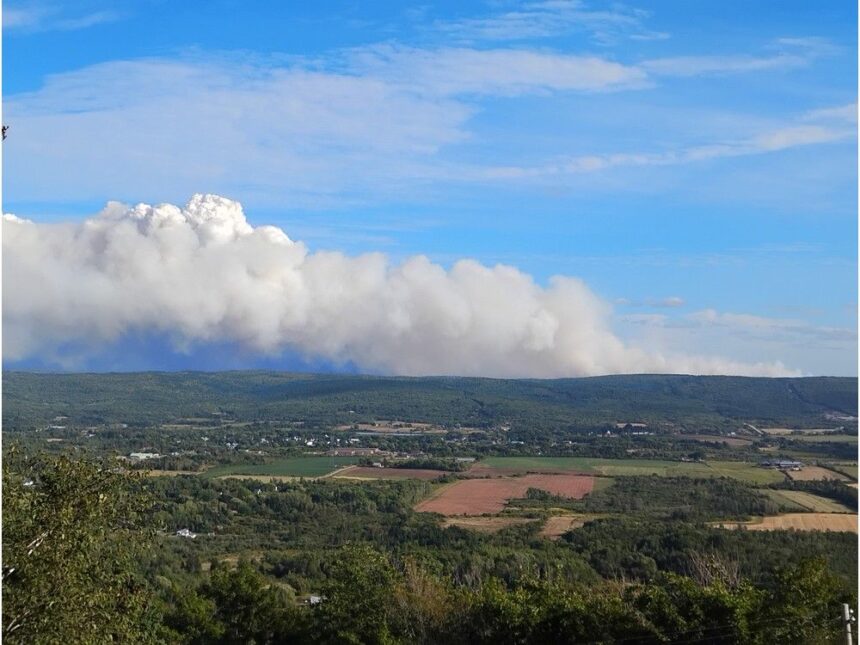Smoke from the Long Lake wildfire as seen Aug. 24 from Valleyview Provincial Park in Hampton, five kilometres north of Bridgetown. Photo by Lawrence PowellArticle contentAs Nova Scotia grapples with one of its most severe wildfire seasons, a controversial decision by the provincial government has flown under the radar: the approval of aerial glyphosate spraying on 3,577 acres of drought-stricken, fire-prone forest. This move not only risks human health and ecosystems but also exacerbates the very wildfires it claims to mitigate.THIS CONTENT IS RESERVED FOR SUBSCRIBERS ONLY.Subscribe now to access this story and more:Unlimited access to the website and appExclusive access to premium content, newsletters and podcastsFull access to the e-Edition app, an electronic replica of the print edition that you can share, download and comment onEnjoy insights and behind-the-scenes analysis from our award-winning journalistsSupport local journalists and the next generation of journalistsSUBSCRIBE TO UNLOCK MORE ARTICLES.Subscribe or sign in to your account to continue your reading experience.Unlimited access to the website and appExclusive access to premium content, newsletters and podcastsFull access to the e-Edition app, an electronic replica of the print edition that you can share, download and comment onEnjoy insights and behind-the-scenes analysis from our award-winning journalistsSupport local journalists and the next generation of journalistsRegister to unlock more articles.Create an account or sign in to continue your reading experience.Access additional stories every monthShare your thoughts and join the conversation in our commenting communityGet email updates from your favourite authorsSign In or Create an AccountorArticle contentArticle contentGlyphosate, the active ingredient in herbicides, is sold under various brand names with Roundup being the most recognized brand used in home and agricultural contexts while VisionMax is the primary product name for glyphosate herbicide sprayed on Nova Scotia forests.Article contentArticle contentGlyphosate is no stranger to scrutiny. Classified as “probably carcinogenic to humans” by the World Health Organization, it has been linked to cancers, liver damage, and reproductive harm in studies spanning decades. Yet, beyond its toxic legacy, glyphosate’s role in worsening wildfire risk is a stark example of short-term industrial interests overriding long-term public safety. For communities near spray zones, the carcinogenic burden is now paired with heightened fire vulnerability.Article contentArticle contentThe science of spraying dangerArticle contentGlyphosate-based herbicides are used in forestry to kill deciduous plants and shrubs that compete with commercial softwood species. However, this practice replaces diverse, resilient forests with flammable monocultures. By inhibiting plant growth and causing vegetation to wilt and die, glyphosate leaves behind dry, combustible biomass — effectively turning forests into tinderboxes. In a province already parched by drought and under travel bans due to fire risks, adding fuel to the fire is nothing short of reckless.Article contentArticle contentThe government’s silence on spray locations compounds the danger. Unlike previous years, officials have withheld detailed maps and site-specific approvals, citing fears of public occupation rather than prioritizing transparency. This lack of disclosure prevents residents from avoiding exposure or understanding the full scope of fire hazards in their communities.Article contentArticle content This map shows locations across mainland Nova Scotia approved by the Department of Environment and Climate Change for aerial and ground spraying of glyphosate-based products in 2023, including three in the Annapolis Valley. ScreengrabArticle contentArticle contentArticle contentArticle contentHealth and fire: a dual crisisArticle contentNova Scotians are left navigating a dual threat: the chronic health risks of glyphosate and the acute peril of wildfires. Recent research from the Global Glyphosate Study found that even low doses of glyphosate cause multiple types of cancer in rats, with early-onset leukemia and rare tumours observed at levels regulators deem “safe.”Article contentThe link between glyphosate and wildfires is not theoretical. In 2023, Nova Scotia’s government removed spray maps from public view at the behest of Forest Nova Scotia, an industry group. Today, the premier’s director of communications is a former executive of that same organization. This relationship leaves the impression that policy decisions may prioritize industry interests over those of Nova Scotians.
Commentary: Glyphosate: The hidden fuel in Nova Scotias forest fire crisis











